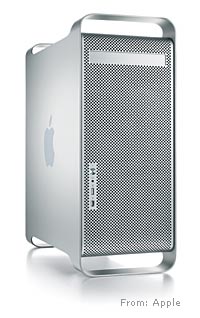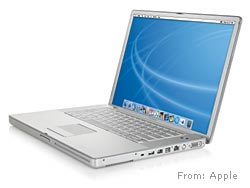
NEW YORK (Fortune Magazine) -
Apple asserts that its new dual-processor Power Mac G5 is the world's fastest personal computer.
Yawn.
Apple and its Windows-side competitors have sniped and snitted for years over rigged benchmark tests -- remember, there are lies, damned lies, and technical benchmarks -- but we all know that today's fastest PC will be a pathetic also-ran by the time we've finished paying for it. In the case of the two-brained G5 I've been testing, that's more than $4,000 from now.
Even so, the dual-processor G5 is better and faster than anything Apple has ever done before. It is even faster than Frankenbox, the homemade Pentium-based PC that I assembled (and wrote about) this summer. On some applications, like a 64-bit optimized version of Adobe Photoshop, the G5 is untouchable. On others, like Microsoft Office, it's too close to tell, or to care.
 |
|
| Apple G5 |
One thing that's for sure is that the G5 is the biggest advance in computing in recent years, and not just because it is the first personal computer to use a 64-bit desktop processor. The 64-bit G5 chip, designed by IBM and Apple, handles twice as much data in one pass as the 32-bit processors that are used in mainstream PCs today. It also allows the Power Mac G5 to address up to eight gigabytes of system memory, which is of great significance to people who design rocket ships and drugs, make professional music videos, edit magazine photos, or simply have to have the baddest computer on the block.
The G5 is literally the biggest thing Apple has ever done. I mean, it's an absolute tank, tipping the scales at 45 pounds and dwarfing the pillow-sized Power Mac G4 that preceded it. The new industrial design of anodized aluminum will please some people and annoy others; there's nothing warm and fuzzy about it. Well, nothing fuzzy, at least. Normally a pair of 2GHz G5 chips would put off enough heat to warm a small room, but in a tour de force of engineering, Apple has made the G5 both cool and quiet. The inside of the G5 is a work of art, with four separate airflow zones, each with one or more nearly silent, computer-controlled fans.
 |
YOUR E-MAIL ALERTS
|
Follow the news that matters to you. Create your own alert to be notified on topics you're interested in.
Or, visit Popular Alerts for suggestions.
|
|
|
Nerds will drool at the speed and bandwidth of the G5's internal data pipes; details are on Apple's website. Smaller touches will appeal to nondweebs as well, like the placement of FireWire and USB 2.0 ports and a headphone jack on the front of the machine. On the back and inside the easy-open case are other connectors, including PCI-X slots (a faster version of industry-standard PCI slots), optical digital audio in and out ports, a FireWire 800 port (nearly twice as fast as USB 2.0), gigabit Ethernet, and (optionally) two flavors of wireless networking, Airport Extreme and Bluetooth.
Should you plunk down $2,000 and up -- way up, depending on options -- for one of these new G5 monsters? If you're a professional and have a need for speed, of course. Consumers might wish to wait for the prices and new technologies to settle a bit. Besides, there are only a few software titles right now that take advantage of the 64-bit processor.
A sure thing for Apple enthusiasts is the recently updated 15-inch wide-screen PowerBook. It replaces the titanium model (which, users discovered, had a lot of silver-painted plastic) with one made of brushed aluminum. I still consider the titanium PowerBook to be one of the best notebooks ever made, and the new aluminum model improves on it in several ways. However, the improvements are mainly carryovers from the more recent 12-inch and 17-inch PowerBooks, which introduced the backlit keyboard with ambient light sensors; AirPort Extreme 802.11g wireless networking (standard on the more expensive PowerBook, optional on its cheaper sibling); Bluetooth, USB 2.0, and FireWire 800 data ports; and a digital video interface (DVI) port for connecting a desk-bound PowerBook to one of Apple's brilliant flat-panel displays.
 |
|
| Apple Powerbook G4 |
The 1.25-gigahertz PowerBook G4 model I tested came with 512 megabytes of system memory, an 80-gigabyte hard drive, and a slot-loading SuperDrive DVD-R/CD-RW optical drive and cost $2,599. It never got Apple's claimed 4.5 hours of battery life, but it lasted long enough to watch a three-hour DVD. There's a cheaper ($1,999) model, but it has 256 MB of memory, a 60GB hard drive, and a DVD-ROM/CD-RW Combo drive. Again, it's a tool for professionals and well-heeled lovers of elegant technology. Consumers may find that the cheaper iBooks meet their needs just fine. If you've got the silver, however, the new aluminum Macs let you put the pedal to the metal.

|

